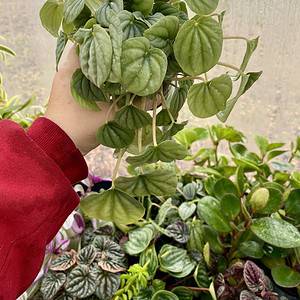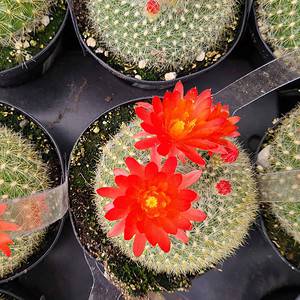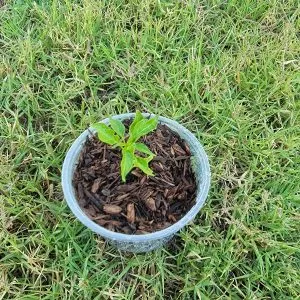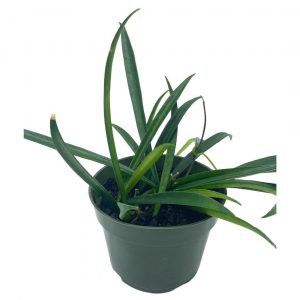No products in the cart.
Table of Contents
The curry leaf plant, scientifically known as Murraya koenigii, is a small evergreen shrub native to South Asia. Its aromatic leaves are a staple in various cuisines, imparting a distinct flavor to dishes.
Beyond its culinary use, this plant also holds significance in traditional medicine and is cherished for its ornamental qualities.
What is Curry Leaf Plant?

Did you know that Curry Leaf ( Murraya koenigii ) has several health benefits? From good skincare to hair nutrients to cholesterol burner, curry leaves are also best when you need an extra aroma for your soup or stew. These are enough reasons for you to plant curry leaves at home.
This low-maintenance Curry Leaf Plant is native to India. The plant belongs to the citrus family. It has a strong aroma and spicy scent, with a bit of citrus quality.
Curry Leaf Plant can grow from a small bush to a 20 feet tall tree. Curry Leaf produces white flowers that turn into tiny black fruit that is only edible when the poisonous seed is removed. This fantastic plant thrives best during sunny days and is recommended to be placed in a space where the sun shines the most.
Curry Leaf Plant Care Basics
Growing curry leaf plants requires less effort, but they will not survive without proper care and attention. Below, you will know some essential care tips for your curry leaf plants.

Recommended Potting Mix
The Curry leaf plants prefer to be on moist, well-drained soil. It must have a pH that’s slightly acidic. A general potting mix will do. You may add a half amount of organic matter such as compost or animal manure to aid the growth of the plant.

Watering Needs
The Curry leaf plant will thrive with weekly watering during the spring and cooler months of the year. However, during the hotter months, it may be necessary to water every day to ensure that the soil does not become too dry due to the heat.
When it’s chilly outside, you’ll also want to minimize the water you feed the plant because it’ll most likely be dormant.
Ensure that the roots of this plant do not become submerged in water, as this can lead to root rot and other diseases. You won’t need to water the plant as much after it reaches maturity.
Recommended Lighting

This plant requires full sun to flourish. So, it would be best to treat them as an outdoor plant. If you initially placed it indoors, make the transition slow. Allow it to be accustomed to outdoor light first before being given more than six hours of sunlight every day.
This will prevent the leaves from wilting under sudden exposure to direct sunlight.
Temperature & Humidity
Temperatures below 40 degrees Fahrenheit (4.4 degrees Celcius) are not conducive to the growth of the curry leaf plant. Generally, the environment should be 65 degrees Fahrenheit (18 degrees Celcius) or warmer. It can withstand mild freezing temperatures but requires a lot of attention in the winter.
If it gets too cold, it sheds its leaves and lies dormant until spring, when new growth will begin. It would be best to put it in a container where you can move it inside during cold seasons. Curry leaf plants are native to areas where the weather is hot and humid for most of the year.
Curry leaf plants thrive in moist environments, so keeping them indoors during the spring or summer months will cause them to wilt.
Fertilizer

Curry leaves don’t need regular fertilization. In a month or two, use a nitrogen-rich fertilizer to stimulate growth. This will also help the growing curry leaves to turn lush.
Don’t fertilize when the plant is in its dormant period, which occurs in the winter in colder climates. Because the curry leaf plant can be iron deficient, you can add a teaspoon of iron sulfate to the soil once a month. One symptom of iron deficiency is when the younger leaves develop chlorosis or yellowing in between their veins.
Propagation
When it comes to the propagation of the curry leaf, it is mainly through the seeds or the cuttings of the plant. You can sow seeds directly on the germinating mix. Keep it moist and place it under warm conditions.
For cuttings, you may take a portion of the healthy stem. Plant it in a potting mix. You can use a gallon container for this type of propagation. Water it well and let it sit under partial shade until it develops new leaves.
Growth Zone
The curry leaf tree can reach a size of 6 to 15 feet when grown outside. It thrives best in places under growing zones 10-12.
Repotting
If you’re growing a curry leaf plant indoors, you’ll need to repot it every year or every two years. It will depend on how big or small the container that you’ve used in potting. Never allow this curry tree to be pot-bound. Since it’s a tree, its roots are extensive.
Therefore, it needs enough space for growth down below. Repot your curry plant to a larger container. Make sure to trim dead and aged roots.
Remove the old soil mix but be careful not to damage the root system. Prepare a well-draining, fresh set of mix and add slow-release fertilizer. Then, you may plant a curry tree in its new home. Don’t forget to water it well.
Pruning

Pruning is needed for this plant, but it is optional. If you opt to prune, do this early in its growth stage. You can do top pruning to arrest the plant’s height and encourage lateral growth.
To do this, cut the first 4 inches from the top. The recommended tool for this is manual pruning shears. Have it sterilized first so no pathogen will enter and infect the wound?
So, when will the curry leaf plant be pruned? It is best to prune it after the last frost because it can damage the plant’s sprouts.
-
$18.00Sold By: Smoot's Farm
In stock
Peperomia Frost 2.5 Inch Pot Beautiful Live Silver Green Plant
Rated 4.89 out of 5 based on 27 customer ratings00Sold By: Smoot's Farm -
$8.99 – $12.99Sold By: Succulent Oasis
In stock
Scarlet Crown or Notocactus Haselbergii | A lovely cactus that produces amazing blooms
Rated 4.84 out of 5 based on 352 customer ratings16Sold By: Succulent Oasis -
$60.00Sold By: Ralph Plants
$70.00Only 1 left in stock
Alocasia Tigrina (Growers Choice)
Sold By: Ralph Plants -
Free Shipping$15.00Sold By: D&D simplicity products
In stock
Lemongrass 5 unrooted cuttings
Sold By: D&D simplicity products
Curry Leaf Plant Varieties
As for the curry leaf plant, there are various kinds of it: regular, gamthi, and dwarf.
The difference between the three is that the regular can grow from 6-15 feet high as 4-12 feet wide, the dwarf has giant leaves, and lastly, the gamthi has a small leaf structure fragrant and thick. ]
Curry Leaf Plant Diseases & Pests
Diseases
The primary disease that happens on the Curry leaf is the leaf spot. It is where there are round spots or lesions on the leaves. A primary cause of this is unhealthy soil or rain splash, while the second reason for this could be the air or the weather condition.
To prevent such, always ensure that the growing conditions are properly met.
Pests
Even if you treat curry leaves as an indoor plant, they can still be infested by pests such as fungus gnats, whiteflies, aphids, scales, and spider mites. A way to get rid of the problems is by washing or spraying the plants with water or any organic solution that is good for the plant.
Frequently Asked Questions
Suppose your curry plant stops growing, maybe because you haven’t given any fertilizer for it to grow. Yes, the curry leaf plant does not need much fertilizer, but it is best to give fertilizer once in a while. Curry plants are usually slow in growing because they lack iron.
If you happen to over prune the leaf plant, then growing back will become a struggle. You may add fertilizer to help it give a boost of the nutrients it needs.
Curry leaf plants usually dry up when the winter season comes. It’s preparing itself for the cold temperature. But in some cases, it dries up maybe because of less exposure to light, low humidity, improper soil, or water stress.
During winter, care for curry leaf plants by:
- Bringing indoors if in colder climates.
- Placing near a bright window.
- Allowing the top inch of soil to dry before watering.
- Providing occasional misting to maintain humidity.
- Avoiding drafts and cold temperatures.
Water a curry leaf plant moderately, allowing the top inch of soil to dry before watering again. Frequency depends on factors like temperature and humidity. Typically, water every 1-2 weeks in warmer months, reducing to every 2-4 weeks in colder months. Adjust based on plant’s specific needs and environment.
Epsom salt can benefit a curry leaf plant when used occasionally as a magnesium supplement. Dissolve a teaspoon of Epsom salt in water and apply to the soil. However, it’s important not to overuse it, as excessive magnesium can disrupt the plant’s nutrient balance.
Whether you want to buy, sell or simply reach out to other plant enthusiasts, Plantly is the right place to be!
-
$12.99Sold By: Succulent Oasis
In stock
Medium Sedum Aurora also known as Jelly Beans
Rated 4.84 out of 5 based on 352 customer ratings00Sold By: Succulent Oasis -
Free Shipping$20.00Sold By: Blessed Family Farm
In stock
Live Cayenne Pepper Plant
Rated 4.82 out of 5 based on 22 customer ratings03Sold By: Blessed Family Farm -
$11.99Sold By: Succulent Oasis
In stock
Medium Silver Torch Cactus – A spiny, cylindrical cactus.
Rated 4.84 out of 5 based on 352 customer ratings02Sold By: Succulent Oasis -
$19.99Sold By: BubbleBlooms
In stock
Hoya Kentiana, Very full 4″ potted starter, ready for 6″ pot, Honeyplant Waxplant Porcelain Flower
Rated 4.81 out of 5 based on 279 customer ratings01Sold By: BubbleBlooms











